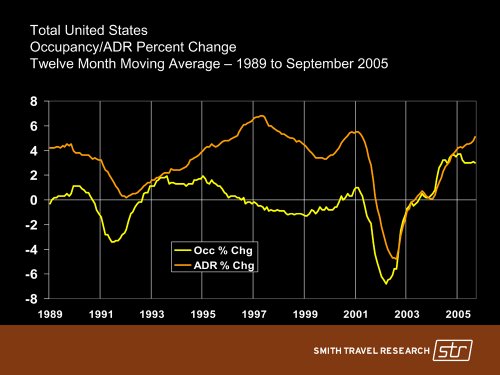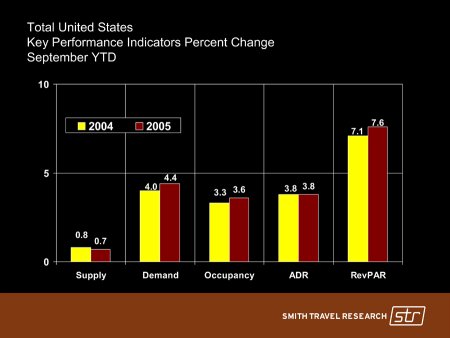| The Global
Hospitality Advisor
Outlook 2006:
|
 |
|
|
| The Global
Hospitality Advisor
Outlook 2006:
|
 |
| December 2005
Jim Butler, Chairman of JMBM�s Global Hospitality Group, recently chaired a roundtable with some of the leading voices in the hospitality industry, seeking insights about the outlook for the industry in 2004. Joining Jim in this year�s roundtable discussion are:
.  Smith: Particularly surprising at this stage of the recovery is that the RevPAR increase of 7.6 percent is coming almost equally from occupancy and ADR gains. .  Tom Corcoran: I think the continued strong RevPAR growth is the biggest story in the industry. The kind of sustained growth we have been experiencing is very unusual in this business. Bruce Baltin: Yes, it is unusual�and while
we are solidly in the expansion phase of this cycle�after two years of
ADR growth well above CPI growth, the challenge will be to justify continued
strong rate increases.
 Butler: How will the industry make that case to consumers? Baltin: Existing product will have to be renovated and upgraded to higher standards, especially since new product is not coming on the market due to construction costs going through the roof. Butler: What does new development look like? What is in the pipeline? Smith: There is a bit more development
going on today than there was a year ago, and projects in the final planning
stages are up 15.1 percent over last year�s number. But there are half
as many projects in the pre-planning stages as this time last year.
 Smith: The low supply growth has been perhaps the greatest surprise�we haven�t seen this wide a difference between demand and supply growth since the late 1970s. We are clearly entering a period of sustained demand growth that is well in excess of supply growth. .  Baltin: With limited supply growth, many markets �especially on the coasts�are at or near capacity occupancy. So, revenue growth is going to have to come from room rates. Bruce Wiles: Rate growth is the key to profitability. We as an industry need to price our product rationally so that rates reflect all the costs of our product�including capital. It never ceases to amaze me that the industry ignores the cost of depreciation when profitability and rates are evaluated. There is a fundamental disconnect between a hotel operating statement and the reality of owning the real estate. The increasing level of capital investment into the hotels is a challenge for all of us. Tom Engel: While both �buying sides� of the industry�the public and private equity markets�continue to source new acquisitions, there is a growing caution regarding investment costs per room and mandated, new brand standards that add further cost to ownership. The reality is that other real estate property types�office, retail, industrial �are experiencing the same phenomena. Wiles: True, but brand and guest requirements in our industry continue to grow. Butler: Let�s talk about the guest�s expectations. The luxury segment of the market continues to lead the industry in increased demand�4.9 percent over last year. Is this a reflection of increased expectations? Laurence Geller: Guests expect more amenities and a variety of available facilities. We have seen modern airports morph into places with instant access to a variety of food and retail outlets in response to this expectation. Guests want more individually tailored services, they want flexibility and they want it instantly. Bill Blackham: Accurately anticipating the guest experience of the future with the ever-increasing number of �Generation X� customers and the lifestyle elements they seem to prefer, is a very real challenge in our industry. Engel: My TRE colleagues are skeptical of the long-term viability of all the new �lifestyle� brands, particularly in attracting and retaining the core industry consumer: midweek customers traveling on business. No one wants �boring,� but theatrical design and theatrical service style can be even worse for the rank and file business traveler. Baltin: With several new brands out�lifestyle and otherwise�and limited supply growth, not all of the new brands will make it. If they do, the ramp up will be slower than hoped for. Justin Schuman: I believe you�ll see a trend of more extensive and expensive Product Improve-ment Plans from the different brands in order to keep their edge in the marketplace and meet the expanding expectations of guests. With construc-tion costs so high and little new ground-up development, the brands will need to start requiring more thorough PIPs and renovation plans. Wiles: Our ability to deliver guest-satisfying experiences is also dependent upon our employees �at all levels. A large issue in this industry is attracting and keeping qualified people in the business. We need to find engaged people and keep them motivated. We cannot run an industry with a traditional 50 percent turnover rate and believe we are doing the right thing for our people, our guests or our investors. Butler: Well, you must be doing something right, Bruce�the MeriStar portfolio is pretty impressive. Can any of you comment on how your company did this year? Wiles: In 2005, MeriStar is producing RevPAR
and operating margin growth near the top end of performance levels for
its tier. We have invested substantial sums to improve our assets while
we took advantage of the run up in asset pricing to sell a number of assets
to improve the composition of our portfolio. We evaluated a number of transactions
on the investment side to strengthen our portfolio even further but could
not get to the pricing levels that the market drove.
Corcoran: Well, the final results are not in for 2005 yet, but at this point we are seeing much stronger RevPAR numbers than we had anticipated. Right now, our earnings expectations are much stronger than we thought they would be a year ago. We believe this growth will continue into 2006. Jonathan Roth: At Canyon Capital, approximately 25 percent of the $400 million of capital we deployed�or have committed to deploy in 2005�was devoted to hospitality product. In several instances our capital was utilized for the acquisition and repositioning of mature assets and in some instances it was provided to acquire and reposition mature hotels as condo hotel projects. I anticipate that in 2006, we will have the same allocation towards hospitality product. Blackham: At Eagle Hospitality, we were successful in growing the company about 50 percent by acquiring hotels in our geographic target markets that met our quality and features objectives. We were able to diversify while adhering to our strict criteria. We also positioned our balance sheet with favorable debt that is substantially fixed with very attractive interest rates. Butler: Ah, yes. Interest rates. Let�s talk to the hotel finance gurus and find out what they saw in 2005 and where they think we�re headed. Christof Winkelmann: Once again, this year has �outperformed� last year in terms of availability of capital and the willingness to invest it into the hospitality industry. Cap rates have come to a historical low despite increasing interest rates. Hotel performance has increased to all-time highs at a time when supply growth is restrained or possibly even decreasing in some markets, like New York City, due to hotels being converted to residential product. For 2006 I see a clear continuation of this trend, albeit at a slower pace. Frank Anderson: In 2005, capital was readily available virtually throughout the country and across all product types. We saw significant pricing compression and structuring erosion noted throughout the year. The relative absence of serious loan delinquencies or defaults will in all likelihood encourage some new entrants to the market and continue the trends of 2005 into 2006. Hotel markets are functioning quite well and, barring some type of event risk, we will continue to enjoy RevPAR growth into 2006 and beyond. Patrick O'Neal: Competition� demand� great product� more competition� more demand� rate compression� some great product� some garbage. That was 2005. There were less than six real CMBS hotel lenders in the fourth quarter of 2004. By the end of the first quarter 2005, that number had tripled, and now it includes virtually everyone who can spell �hotel.� Initially, good quality hotels replaced many other product types as the darlings of the CMBS lending industry�limited new supply with limited planned construction was shifting the demand curve rapidly to provide for soaring RevPARs. The demand for hotel loans was now being driven as much by the lenders� demand as it was the borrowing community. This caused spreads to compress and become more normalized across the industry for certain hotel segments. Winkelmann: For 2006, construction will pick up, but increasing interest rates will put pressure on widening cap rates. Towards the latter half of the year I would pay close attention to hotel values. You keep reading in the newspapers about the �real estate bubble,� especially in relation to the private housing market. Values are already coming down in this sector and that is usually a pretty good indicator of where the industry in general is heading in the short-to-medium future. Anderson: The finance side of the market is the industry�s greatest challenge. Unsustainable cap rate compression is leading to purchase prices that appear prohibitively high to meet most investors� return hurdles. Additionally, you wonder, based on some recent shoddy underwriting, if the credit function has taken a holiday at some institutions. You have marketing officers pointing to manageable 70 percent or 75 percent loan to values, when appraisals less than two years earlier on the same property might indicate a loan to value in excess of 100 percent if a traditional cap rate was employed. O'Neal: Many experts�who are those �expert� guys, anyway? �are predicting a continual increase in treasuries and in overall interest rates. If they are right, either the lender or the borrower has got to budge. Rising interest rates do not favor continued low cap rates or high sales prices. CMBS lenders got much more aggressive in 2005 in LTV, DSCR and amorti-zation requirements. But if interest rates increase enough, the math won�t work anymore. Either sales prices (and real values) will have to decline, or lenders will need to extend their underwriting standards even further. The continuing coinci-dence of 75 percent LTV at 1.40 DSCR on a 25-year amortization will be impossible. Butler: How will they change if treasuries continue to rise? Is there a correction on the horizon? O'Neal: The overall dynamics of the entire market will change. I think lenders will continue to be aggressive, but look for the investment criteria to become more conservative. The lenders� rubber band is already squeaking from being stretched too far. Anderson: Underlying hotel fundamentals are strong, so a market correction would be unfortunate. But in a rising interest rate environment, cap rates will return to more normal levels. You have to ask: How will the refi gaps be covered that are sure to arise? And who will cover the gaps? It is in difficult situations like these that HSH Nordbank�s steady role as a reliable banking partner will be of most use to its valued relationship banking clients. Butler: How did your financial institutions benefit from this year�s market? Has it affected the way you work with borrowers? Anderson: HSH Nordbank AG completed its first full year with a �stand alone� dedicated hotel and leisure lending practice. Unlike many lenders, we intend to hold loans on the balance sheet of HSH Nordbank. It�s worked out well for our borrowers, who recognize the speed and efficiency this approach brings to deals. HSH Nordbank will continue in 2006 to focus on those opportunities where we can support existing client relationships on any reasonable basis for those trans-actions which are outside the commoditized norms. Specific-ally, transactions like financing ground-up construction and development as well as deep renovation and repositioning. We also have a willingness to selectively provide �mezz debt� behind our own lead-arranged first mortgage. We seek ongoing relationships that last beyond the first loan closing. Roth: Frank, that really sets HSH Nordbank, Canyon Capital and a handful of other capital providers apart from the crowd. Although there is a lot of capital chasing hospitality trans-actions, this capital tends to be most aggressive for stabilized assets and quite challenging for new ground-up development. Winkelmann: In 2005, Aareal Bank successfully closed its first transaction in Mexico and significantly expanded its portfolio in Canada. In the United States, we refinanced some existing debt, and provided some acquisition as well as some renovation financing. As a portfolio lender, we continue to hold a very substantial portfolio of assets in the U. S. and will plan to increase our U.S. lending activities in 2006. Besides this, we are very active in Europe, Russia and Turkey and have entered the Asian market with the partial acquisition financing of the Raffles Portfolio. In terms of focus, we look at everything from re-financing to repositioning, but are exclu-ding pure construction financings. This includes single asset transactions, as well as large portfolios. Butler: OK, gentlemen, it�s time to pass around the crystal ball and tell us what you see for 2006. Engel: Transaction volume will remain strong among sexy assets like destination resorts and landmark, infill urban hotels where owners will look to harvest available equity in the properties, and private equity pushes itself to invest its latest equity raise. Overall industry profitability will grow in 2006, but only the strongest and well-managed existing hotels will do so in any meaningful way at +8 to 10 percent or more. Finally, brand management will truly come into its own in 2006 and further become the instrumental key in determining full service hotels� success. Roth: There is still a tremendous amount of relatively inexpensive capital available for hotel acquisitions and recapitalizations for stabilized product and, barring an extraordinary event, I see this continuing through 2006. Additionally, there will still be a significant amount of non-traditional capital providers (such as hedge funds and money management firms) in the marketplace, which will fill the shortfall created by the reluctance of mainstream capital providers to fund repositioning opportunities and ground-up development. Wiles: Energy costs will be a major issue in 2006. They will flow through virtually every line item in the operating statements: vendor surcharges, cost of guest transportation, costs of employee commuting and so on. The industry needs to aggressively address the run-up in energy pricing. Baltin: There will be continued cost pressures into 2006: energy and energy related costs, insurance, labor and benefits. Winkelmann: Insurance will be a major issue. Finding willing investors and providers of capital will�to a large part�depend on the availability of affordable and sensible insurance coverage. After the massive destruction suffered in the Gulf this year from hurricanes, insurance rates are sure to have an impact on the bottom line. Butler: Any last pearls of wisdom for those who want to stay in the game and profit from it in 2006? Blackham: Winners will be those who have the discipline to execute business initiatives while remembering that this is a cyclical industry. Despite the low capitalization rates that everyone complains about, prices per key in many markets appear to be less than rapidly increasing replacement costs. As construction costs soar and demand continues to outpace supply, interesting opportunities are created, making this a very promising near term. Wiles: I agree�investment and hotel demand are creatures of the economic cycle. Despite a lot of shocks to the economy, things are progressing well. The increase in values therefore has pretty good support from a fundamental standpoint. Hotel supply at some point will be more relevant, but for right now, the deals will keep occurring at these levels. It is really a tale of two markets. Pricing in the headline deals reflects the scarcity of urban and resort product and the velocity of rates in those markets. In secondary markets and products, it is entirely different. Pricing levels there reflect increasing operating costs and capital investment balanced against the limited rate upside in those products and locales. Corcoran: The greatest opportunity in 2006 is riding the wave of continued RevPAR growth. But counting on RevPAR growth alone for increased revenue is also the greatest risk. Baltin: There will be strong growth in the meetings market and international travel, many will figure out how to use those factors to fuel revenue growth in 2006. Roth: Given the difficulty in attracting debt and equity capital for new urban hotel development, we see developers continuing the move to mixed-use projects with hospitality, residential and retail components. The strong demand for and the ability to pre-lease and pre-sell the retail and housing components serve to reduce the basis and therefore the risk for the hotel comp-onent of the development. I see this trend continuing into the foreseeable future and serving as a catalyst for new and creative hospitality product. O'Neal: Whoever adapts to change the quickest will prosper. Butler: Well
put, Patrick. And we can all count on change in this industry!
.Copyright © 2005 Jeffer, Mangels, Butler & Marmaro LLP (JMBM). All rights reserved. Global Hospitality Advisor® and Ask the Hotel Lawyer� are trademarks/service marks of JMBM. The Global Hospitality Advisor® is published four times a year for the clients and friends of JMBM. |
|
Jeffer Mangels Butler & Marmaro LLP 1900 Avenue of the Stars, 7th Floor Los Angeles, CA 90067-4308 Attn: Jim Butler 310.201.3526 � 310.203.0567 fax [email protected] http://www.jmbm.com The premier hospitality practice in a full-service law firm |